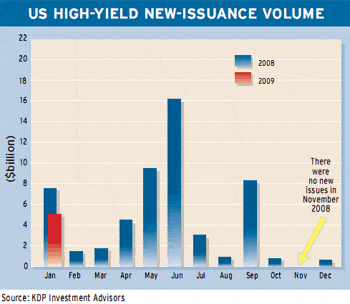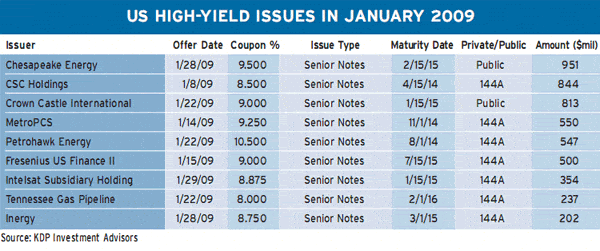Corporate Debt
 Corporate debt markets in the United States have begun to function more normally, and the money supply is expanding rapidly, showing that the Federal Reserve’s credit-easing policies may be working, analysts say.
Corporate debt markets in the United States have begun to function more normally, and the money supply is expanding rapidly, showing that the Federal Reserve’s credit-easing policies may be working, analysts say.
The Barclays Capital Credit index of investment-grade corporate bonds tightened 62 basis points in January, its best monthly performance since the index was introduced in the late 1980s. The best-performing sectors of the fixed-income index included home construction, lodging, airlines and automotive.
Non-government-guaranteed supply picked up materially in January, with about $87 billion of fixed-rated debt issued. That was the highest monthly total since May 2008. Analysts at Barclays Capital, based in New York, cited improved market technical factors and additional government support as reasons for improving spreads on investment-grade debt.
Market sentiment improved after the details of the Fed’s Term Asset-Backed Securities Loan Facility (TALF), announced in November 2008, were finally released. “In particular, we note the favorable haircuts and pricing,” the Barclays Capital analysts said in a report. Haircuts, representing the difference between the market value and the value assessed by the lender, ranged from 5% on short-dated Small Business Administra-tion and student loans to 16% on longer-dated auto dealer-inventory financing.
“Reflecting the attractive funding terms, markets rallied after the release” of the TALF details, according to Barclays Capital. US intervention is also coming in the form of proposed regulation of credit default swaps (CDS), including the introduction of a central clearinghouse.
“We do not believe that a central clearinghouse is the full solution to the counterparty risks that exist in the derivatives market today, as clients will eventually look for segregated margin accounts,” asserts Bradley Rogoff, analyst at Barclays Capital. “However, this is the initial and biggest step that needs to be taken in order to remove systemic risk from the CDS market,” he says.
The financial system has not yet normalized, but there are early signs of improvement, according to Richard Hoey, chief economist at The Bank of New York Mellon and Dreyfus. Commercial paper spreads have narrowed, the high-yield bond market is no longer making new lows, and a calendar of new issues has emerged in the corporate bond market, he says.
“It is notable that when the financial stock indices broke to new lows in early 2009, most stress indicators in the credit markets did not revisit their worst levels,” Hoey said in his latest monthly market commentary, released in early February. The Fed’s actions have succeeded in generating a rapid growth in the money supply, he notes. “Rapid growth in the money supply can help prevent an inflection point to long-term deflation expectations,” he says.
If confidence in the US financial system and the economy is to be rebuilt, the private financial system needs to find its way back from federal life support, Hoey says. The private system needs to have enough credit capacity to easily finance economic expansion, he points out. One key to this will be rebuilding a simpler, sounder securitized sector of the financial system, he says.
Confidence that governments and central banks will prevent an intensification of the financial crisis is returning, and the financial sector is gradually recuperating, Hoey says.

Gordon Platt



